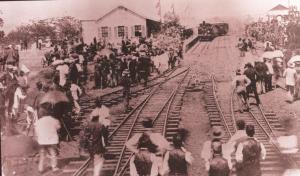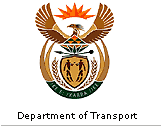 |
HISTORICAL DEVELOPMENT OF THE RAIL SYSTEMThe railways of KwaZulu-Natal perform an essential import
and
export function for traffic between the ports of Durban
and Richards Bay and the hinterland [Gauteng and points
to the north]. Railways in the province were not affected
by the
demarcation of new provincial boundaries in 1994, and the
railway system has remained unchanged.

Durban Point Station and Loco
|
The development of passenger and rail freight transport in
KZN began with the construction of the first railway line
from Durban city to the Point harbour area in 1860. This
railway was constructed to a gauge of 1 435mm (4’-
8½”) but,
when it was decided to build a railway inland, a narrower
gauge of 1 065mm gauge
(3’-
6”) was introduced because of the very difficult
topography. The
line was
opened to Pietermaritzburg in 1880 and extended to Glencoe
by 1889 to exploit coal deposits in the area.
The real goal was to reach the Witwatersrand goldfields.
Volksrust on the Transvaal border was reached in
1895, forming a through route to Johannesburg. The
important Free State link from Ladysmith to Kroonstad was
opened to Harrismith in 1892 and completed by 1906.
The North Coast mainline was constructed when the Durban
to
Canelands section was opened in 1879. This was extended to
Stanger in 1897 and the Tugela River in 1898. The line
later reached Somkele, site of a coal deposit, in 1903.
Golela on the Swaziland border was reached in 1927. The
South Coast mainline was opened to Park Rynie in 1897 and
Port Shepstone in 1907. The first branch line - from Pietermaritzburg to Richmond -
was opened in 1897, and the Greytown branch in 1900. Also
running from Pietermaritzburg, the Cape-
Natal branch was opened from 1904 reaching Franklin in
1912.
Other short branch lines were opened to various
agricultural development areas in the early 20th century,
and this included a number of 610mm (2”-0”)
‘ultra’ narrow-gauge lines to Weenen, Mid
Illovo, Ixopo and Harding.
A number of branch line closures have taken place in
recent years. This has included all 610mm-gauge branch
lines, as well as some 1,065mm-gauge lines.
By contrast,
the development of Richards Bay as a coal export harbour
and the construction of the coal line from Mpumalanga in
the mid-1970s was a significant development, not
only for
the movement of coal but also for a wide range of
commodities.
The Durban to Volksrust (and Gauteng) mainline is South
Africa’s most important general freight line,
and is indispensable for import/export traffic. The
extension of
the North Coast line into Swaziland and Mpumalanga has
promoted development in those areas while the
branch lines in the Midlands provide vital transport for
forestry
products. Other commodities such as sugarcane, refined
sugar products, grains, coal, iron and manganese ore, and
finished steel products flow over various railway lines.

Pietermaritzburg arrival of first train
|
|
 |



